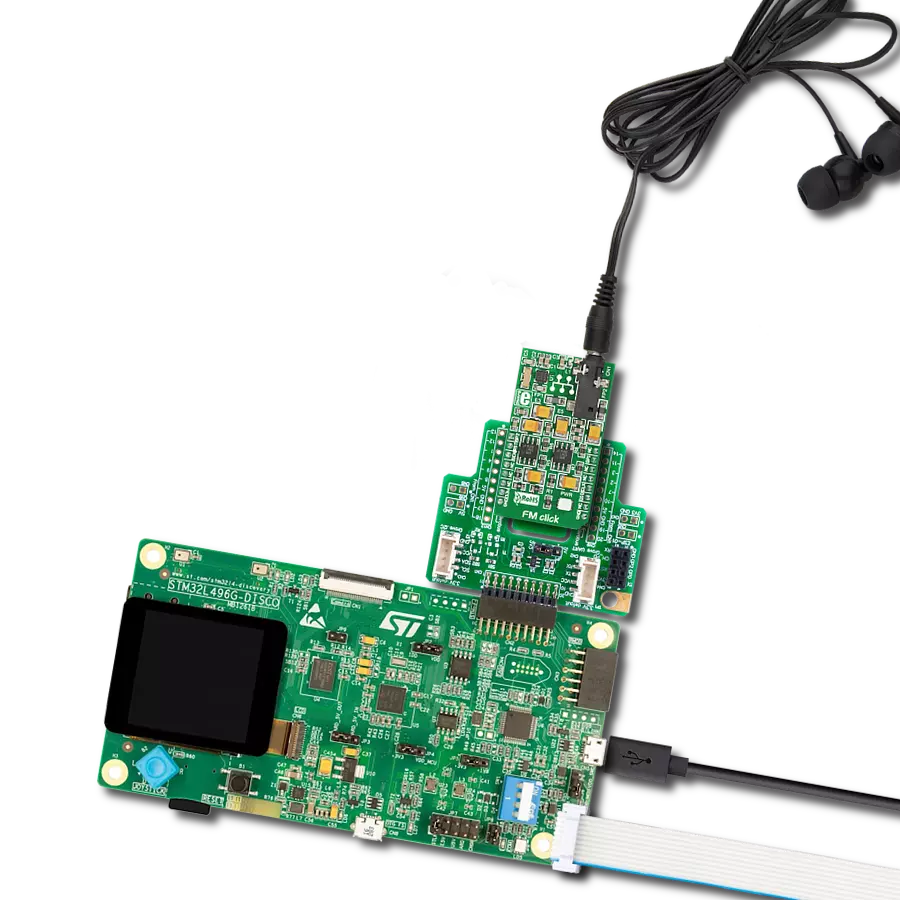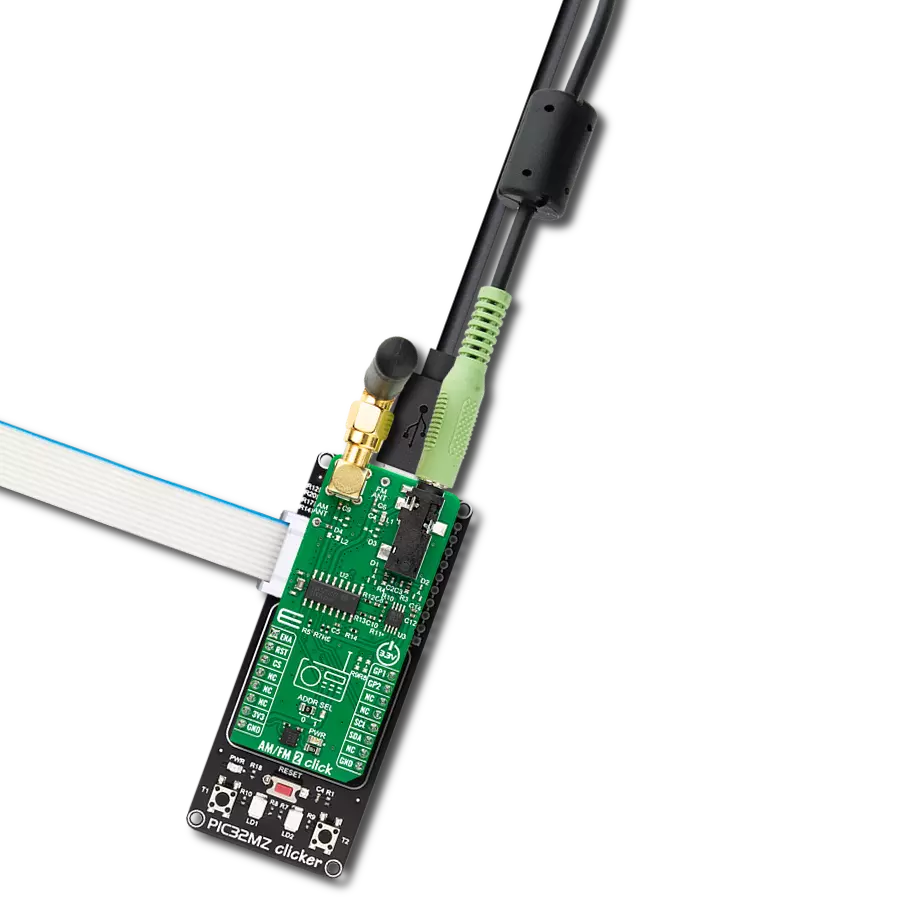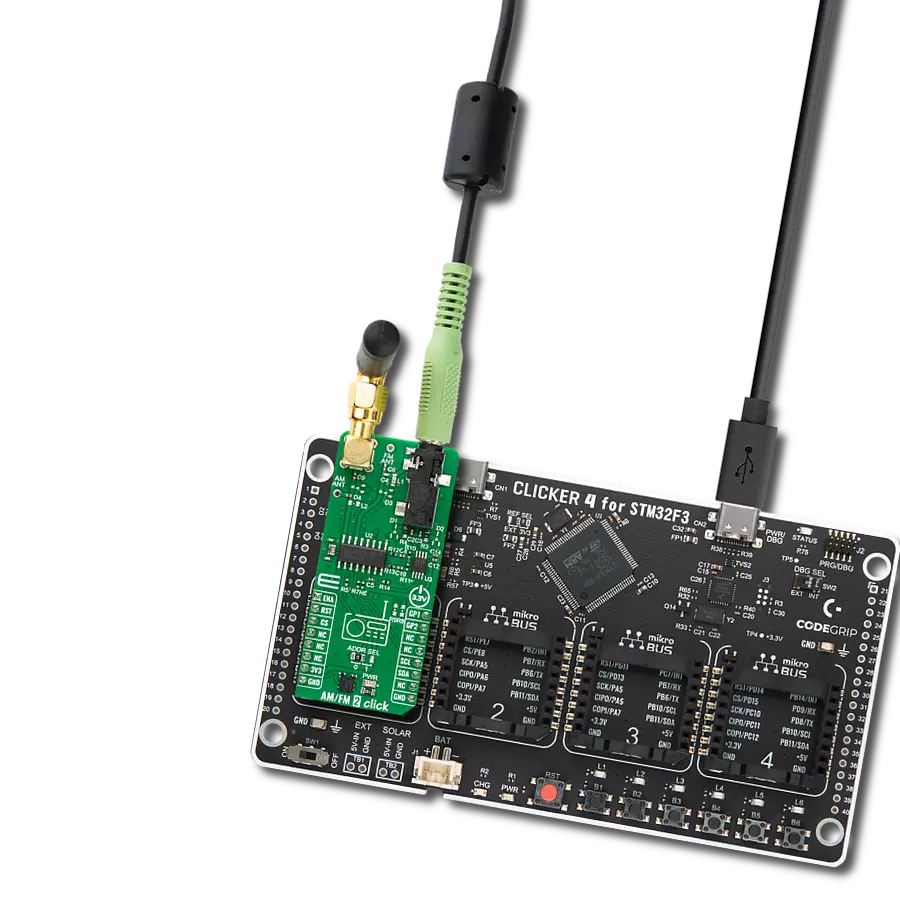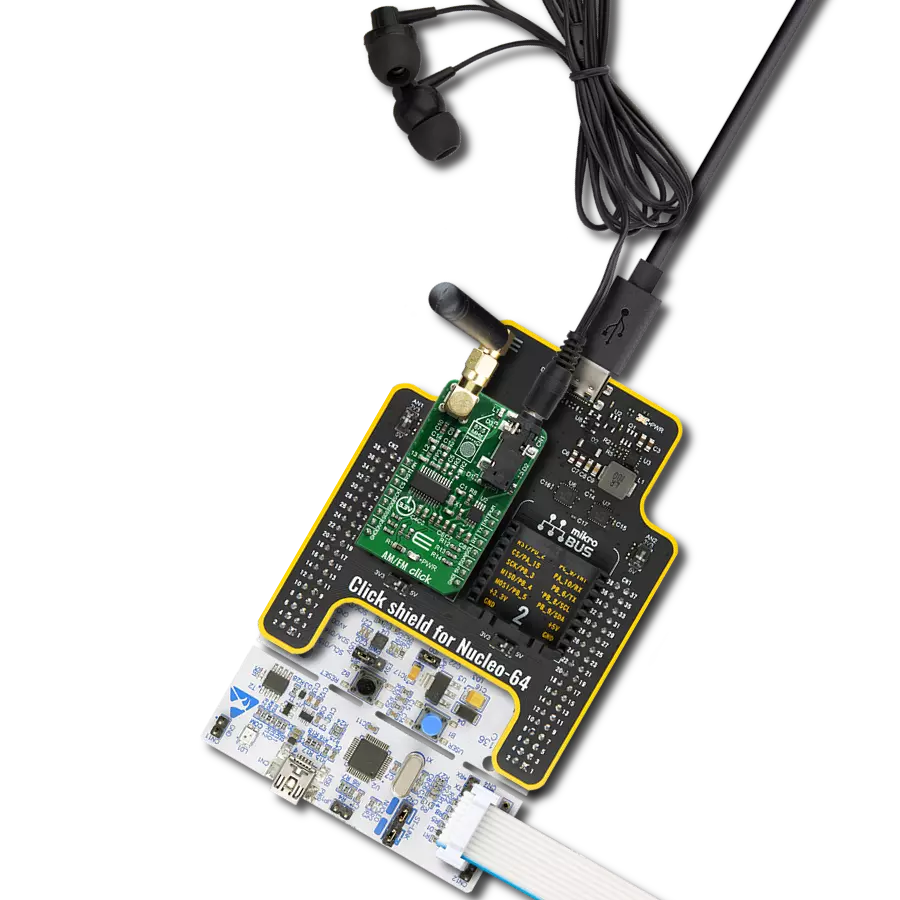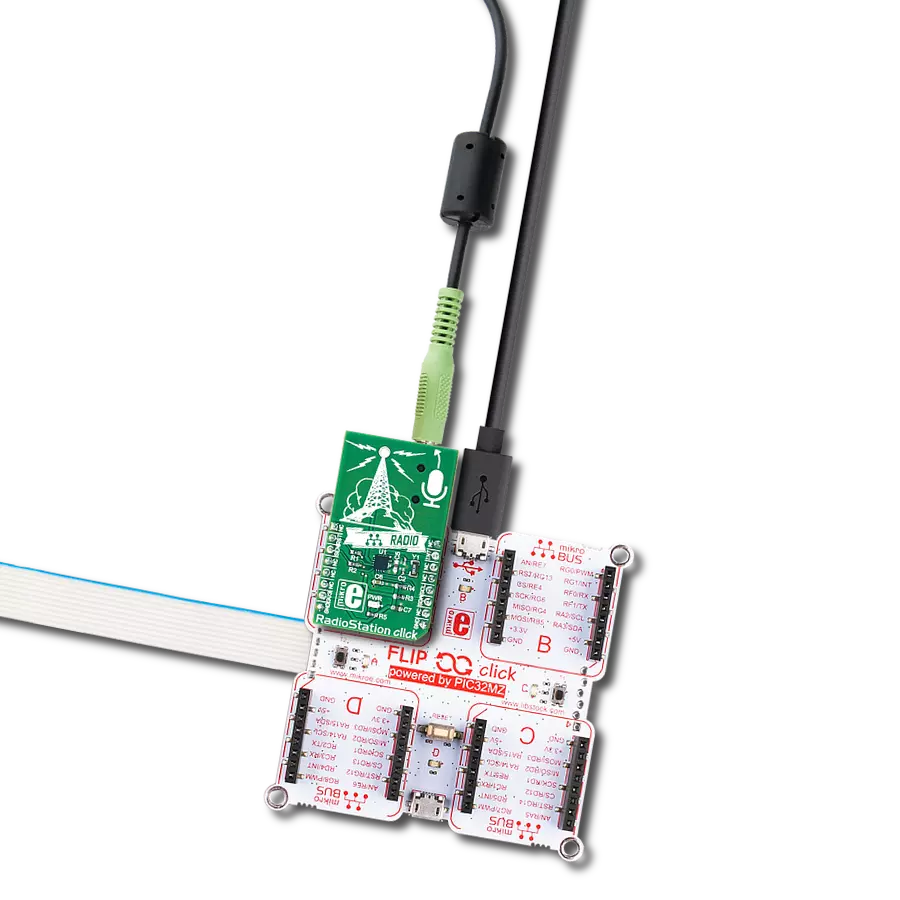Just plug in your headphones and access your favorite stations wherever you go!
A
A
Hardware Overview
How does it work?
FM Click is based on the Si4703, a broadcast FM radio tuner from Silicon Labs. The radio tuner works in a worldwide FM band from 76-108MHz, whereas the antenna uses headphones. The stereo audio connector supports three and four-conductor earphones with a recommended cable length from 1.1m to 1.45m for the best signal reception. The Si4703, one of the industry’s smallest FM tuners, comes with a 32.768kHz reference clock for better frequency tolerance. It has two audio outputs, left and right. Each output uses an LM4864, an audio power amplifier from Texas Instruments, to amplify
the channel outputs. These amplifiers can deliver about 200mW of continuous average power into an 8Ω load. The FM Click is also used as a stereo device and mono. The FM Click can communicate to the host MCU over the I2C serial interface of the mikroBUS™ socket. Besides communication pins, this board also uses several others. The SEN pin routed to the CS pin of the mikroBUS™ socket serves as a serial interface activation signal, which, combined with I2C pins, forms a 3-wire interface. The RST pin is used as a general reset feature alongside two user-configurable pins, GP2 and
GP1, routed to the AN and INT pins of the mikroBUS™ socket. These I/O pins can be used as interrupt requests (seek/tune or RDS ready) or stereo/mono indicators. This Click board™ can only be operated with a 3.3V logic voltage level. The board must perform appropriate logic voltage level conversion before using MCUs with different logic levels. However, the Click board™ comes equipped with a library containing functions and an example code that can be used as a reference for further development.
Features overview
Development board
PIC18F57Q43 Curiosity Nano evaluation kit is a cutting-edge hardware platform designed to evaluate microcontrollers within the PIC18-Q43 family. Central to its design is the inclusion of the powerful PIC18F57Q43 microcontroller (MCU), offering advanced functionalities and robust performance. Key features of this evaluation kit include a yellow user LED and a responsive
mechanical user switch, providing seamless interaction and testing. The provision for a 32.768kHz crystal footprint ensures precision timing capabilities. With an onboard debugger boasting a green power and status LED, programming and debugging become intuitive and efficient. Further enhancing its utility is the Virtual serial port (CDC) and a debug GPIO channel (DGI
GPIO), offering extensive connectivity options. Powered via USB, this kit boasts an adjustable target voltage feature facilitated by the MIC5353 LDO regulator, ensuring stable operation with an output voltage ranging from 1.8V to 5.1V, with a maximum output current of 500mA, subject to ambient temperature and voltage constraints.
Microcontroller Overview
MCU Card / MCU

Architecture
PIC
MCU Memory (KB)
128
Silicon Vendor
Microchip
Pin count
48
RAM (Bytes)
8196
You complete me!
Accessories
Curiosity Nano Base for Click boards is a versatile hardware extension platform created to streamline the integration between Curiosity Nano kits and extension boards, tailored explicitly for the mikroBUS™-standardized Click boards and Xplained Pro extension boards. This innovative base board (shield) offers seamless connectivity and expansion possibilities, simplifying experimentation and development. Key features include USB power compatibility from the Curiosity Nano kit, alongside an alternative external power input option for enhanced flexibility. The onboard Li-Ion/LiPo charger and management circuit ensure smooth operation for battery-powered applications, simplifying usage and management. Moreover, the base incorporates a fixed 3.3V PSU dedicated to target and mikroBUS™ power rails, alongside a fixed 5.0V boost converter catering to 5V power rails of mikroBUS™ sockets, providing stable power delivery for various connected devices.
These standard small stereo earphones offer a high-quality listening experience with their top-notch stereo cable and connector. Designed for universal compatibility, they effortlessly connect to all MIKROE mikromedia and multimedia boards, making them an ideal choice for your electronic projects. With a rated power of 100mW, the earphones provide crisp audio across a broad frequency range from 20Hz to 20kHz. They boast a sensitivity of 100 ± 5dB and an impedance of 32Ω ± 15%, ensuring optimal sound quality. The Φ15mm speaker delivers clear and immersive audio. Cost-effective and versatile, these earphones are perfect for testing your prototype devices, offering an affordable and reliable audio solution to complement your projects.
Used MCU Pins
mikroBUS™ mapper
Take a closer look
Click board™ Schematic

Step by step
Project assembly
Software Support
Library Description
This library contains API for FM Click driver.
Key functions:
fm_get_received_signal_strength_indicator- This function reads recived signal strength indicatiorfm_get_channel_frequency- This function calculates current channel frequency based on band and space settingsfm_get_channel- This function reads CHANNEL bits from READCHAN register
Open Source
Code example
The complete application code and a ready-to-use project are available through the NECTO Studio Package Manager for direct installation in the NECTO Studio. The application code can also be found on the MIKROE GitHub account.
/*!
* \file
* \brief Fm Click example
*
* # Description
* This Click represent FM radio tuner which supports worldwide FM band (76 – 108 MHz)
* and has a set of features such as automatic frequency and gain control, seek tuning and volume control.
*
* The demo application is composed of two sections :
*
* ## Application Init
* Initializing I2C driver, powering up device, setting basic settings for Europe,
* setting values of seek threshold, volume, snr threshold and impulse detection threshold.
* Seek and memorize 5 radio stations with a signal strength above the set limit.
*
* ## Application Task
* Tunes all memorized stations. Switches the stations each 10 seconds.
*
* ## Additional Functions
* - void fm_case_plus( fm_t *ctx ) - Increases volume
* - void fm_case_minus( fm_t *ctx ) - Decreases volume
* - void fm_case_seek( fm_t *ctx ) - Seeks next station
* - void fm_case_tune( fm_t *ctx ) - Tunes default station
* - void fm_case_memorize( ) - Memorizes current station
* - void fm_case_station1( fm_t *ctx ) - Tunes memorized station 1
* - void fm_case_station2( fm_t *ctx ) - Tunes memorized station 2
* - void fm_case_station3( fm_t *ctx ) - Tunes memorized station 3
* - void fm_case_station4( fm_t *ctx ) - Tunes memorized station 4
* - void fm_case_station5( fm_t *ctx ) - Tunes memorized station 5
* - void fm_case_mute( fm_t *ctx ) - Mutes device
* - void fm_case_tune_up( fm_t *ctx ) - Fine tunes frequency
* - void fm_case_tune_down( fm_t *ctx ) - Fine tunes frequency
*
* \author MikroE Team
*
*/
// ------------------------------------------------------------------- INCLUDES
#include "board.h"
#include "log.h"
#include "fm.h"
// ------------------------------------------------------------------ VARIABLES
#define SIGNAL_STRENGTH_LOWER_LIMIT 25
static fm_t fm;
static log_t logger;
static uint16_t received_signal_strength_indicator;
static uint16_t station_channel;
static uint16_t station1;
static uint16_t station2;
static uint16_t station3;
static uint16_t station4;
static uint16_t station5;
static uint8_t memory;
static uint8_t mute;
static uint8_t received_data;
static uint8_t data_ready;
static uint8_t error_flag;
static uint8_t cnt;
static float channel_frequency;
static float tuned_frequency;
static float tune_freq;
// ------------------------------------------------------- ADDITIONAL FUNCTIONS
void fm_case_plus ( fm_t *ctx )
{
error_flag = fm_volume_up( ctx );
if ( error_flag == 0 )
{
log_printf( &logger, "volume up\r\n" );
}
else
{
log_printf( &logger, "volume max\r\n" );
}
}
void fm_case_minus ( fm_t *ctx )
{
error_flag = fm_volume_down( ctx );
if ( error_flag == 0 )
{
log_printf( &logger, "volume down\r\n" );
}
else
{
log_printf( &logger, "volume min\r\n" );
}
}
void fm_case_seek ( fm_t *ctx )
{
fm_seek( ctx );
Delay_ms ( 500 );
fm_end_seek( ctx );
Delay_ms ( 10 );
received_signal_strength_indicator = fm_get_received_signal_strength_indicator( ctx );
channel_frequency = fm_get_channel_frequency( ctx );
station_channel = fm_get_channel( ctx );
}
void fm_case_tune ( fm_t *ctx )
{
error_flag = fm_tune( ctx, tune_freq );
Delay_ms ( 100 );
fm_end_tune( ctx );
Delay_ms ( 10 );
if ( error_flag == 0 )
{
received_signal_strength_indicator = fm_get_received_signal_strength_indicator( ctx );
tuned_frequency = fm_get_channel_frequency( ctx );
station_channel = fm_get_channel( ctx );
log_printf( &logger, "tune complete\r\n" );
log_printf( &logger, "rssi: %u dBuV\r\n", received_signal_strength_indicator );
log_printf( &logger, "tuned frequency: %.2f MHz\r\n", tuned_frequency );
log_printf( &logger, "-----------------------\r\n" );
}
else
{
log_printf( &logger, "frequency not in valid range\r\n" );
}
}
void fm_case_memorize ( )
{
switch ( memory )
{
case 0 :
{
station1 = station_channel;
memory += 1;
log_printf( &logger, "station 1 memorized\r\n" );
break;
}
case 1 :
{
station2 = station_channel;
memory += 1;
log_printf( &logger, "station 2 memorized\r\n" );
break;
}
case 2 :
{
station3 = station_channel;
memory += 1;
log_printf( &logger, "station 3 memorized\r\n" );
break;
}
case 3 :
{
station4 = station_channel;
memory += 1;
log_printf( &logger, "station 4 memorized\r\n" );
break;
}
case 4 :
{
station5 = station_channel;
memory = 0;
log_printf( &logger, "station 5 memorized\r\n" );
break;
}
default :
{
break;
}
}
}
void fm_case_mute ( fm_t *ctx )
{
if ( mute == 0 )
{
fm_mute_enable( ctx );
log_printf( &logger, "mute enabled\r\n" );
mute = 1;
}
else if ( mute == 1 )
{
fm_mute_disable( ctx );
log_printf( &logger, "mute disabled\r\n" );
mute = 0;
}
}
void fm_case_station_1 ( fm_t *ctx )
{
fm_tune_channel( ctx, station1 );
Delay_ms ( 100 );
fm_end_tune( ctx );
Delay_ms ( 10 );
received_signal_strength_indicator = fm_get_received_signal_strength_indicator( ctx );
channel_frequency = fm_get_channel_frequency( ctx );
log_printf( &logger, "station 1 tuned\r\n" );
log_printf( &logger, "rssi: %u dBuV\r\n", received_signal_strength_indicator );
log_printf( &logger, "tuned frequency: %.2f MHz\r\n", channel_frequency );
log_printf( &logger, "-----------------------\r\n" );
}
void fm_case_station_2 ( fm_t *ctx )
{
fm_tune_channel( ctx, station2 );
Delay_ms ( 100 );
fm_end_tune( ctx );
Delay_ms ( 10 );
received_signal_strength_indicator = fm_get_received_signal_strength_indicator( ctx );
channel_frequency = fm_get_channel_frequency( ctx );
log_printf( &logger, "station 2 tuned\r\n" );
log_printf( &logger, "rssi: %u dBuV\r\n", received_signal_strength_indicator );
log_printf( &logger, "tuned frequency: %.2f MHz\r\n", channel_frequency );
log_printf( &logger, "-----------------------\r\n" );
}
void fm_case_station_3 ( fm_t *ctx )
{
fm_tune_channel( ctx, station3 );
Delay_ms ( 100 );
fm_end_tune( ctx );
Delay_ms ( 10 );
received_signal_strength_indicator = fm_get_received_signal_strength_indicator( ctx );
channel_frequency = fm_get_channel_frequency( ctx );
log_printf( &logger, "station 3 tuned\r\n" );
log_printf( &logger, "rssi: %u dBuV\r\n", received_signal_strength_indicator );
log_printf( &logger, "tuned frequency: %.2f MHz\r\n", channel_frequency );
log_printf( &logger, "-----------------------\r\n" );
}
void fm_case_station_4 ( fm_t *ctx )
{
fm_tune_channel( ctx, station4 );
Delay_ms ( 100 );
fm_end_tune( ctx );
Delay_ms ( 10 );
received_signal_strength_indicator = fm_get_received_signal_strength_indicator( ctx );
channel_frequency = fm_get_channel_frequency( ctx );
log_printf( &logger, "station 4 tuned\r\n" );
log_printf( &logger, "rssi: %u dBuV\r\n", received_signal_strength_indicator );
log_printf( &logger, "tuned frequency: %.2f MHz\r\n", channel_frequency );
log_printf( &logger, "-----------------------\r\n" );
}
void fm_case_station_5 ( fm_t *ctx )
{
fm_tune_channel( ctx, station5 );
Delay_ms ( 100 );
fm_end_tune( ctx );
Delay_ms ( 10 );
received_signal_strength_indicator = fm_get_received_signal_strength_indicator( ctx );
channel_frequency = fm_get_channel_frequency( ctx );
log_printf( &logger, "station 5 tuned\r\n" );
log_printf( &logger, "rssi: %u dBuV\r\n", received_signal_strength_indicator );
log_printf( &logger, "tuned frequency: %.2f MHz\r\n", channel_frequency );
log_printf( &logger, "-----------------------\r\n" );
}
void fm_case_tune_up ( fm_t *ctx )
{
error_flag = fm_fine_tune_up( ctx );
if ( error_flag == 0 )
{
Delay_ms ( 100 );
fm_end_tune( ctx );
Delay_ms ( 10 );
received_signal_strength_indicator = fm_get_received_signal_strength_indicator( ctx );
channel_frequency = fm_get_channel_frequency( ctx );
station_channel = fm_get_channel( ctx );
log_printf( &logger, "tune up\r\n" );
log_printf( &logger, "rssi: %u dBuV\r\n", received_signal_strength_indicator );
log_printf( &logger, "tuned frequency: %.2f MHz\r\n", channel_frequency );
log_printf( &logger, "-----------------------\r\n" );
}
else
{
log_printf( &logger, "upper band limit reached\r\n" );
}
}
void fm_case_tune_down ( fm_t *ctx )
{
error_flag = fm_fine_tune_down( ctx );
if ( error_flag == 0 )
{
Delay_ms ( 100 );
fm_end_tune( ctx );
Delay_ms ( 10 );
received_signal_strength_indicator = fm_get_received_signal_strength_indicator( ctx );
channel_frequency = fm_get_channel_frequency( ctx );
station_channel = fm_get_channel( ctx );
log_printf( &logger, "tune down\r\n" );
log_printf( &logger, "rssi: %u dBuV\r\n", received_signal_strength_indicator );
log_printf( &logger, "tuned frequency: %.2f MHz\r\n", channel_frequency );
log_printf( &logger, "-----------------------\r\n" );
}
else
{
log_printf( &logger, "lower band limit reached\r\n" );
}
}
void fm_case_wrong_command ( )
{
log_printf( &logger, "wrong command\r\n" );
}
// ------------------------------------------------------ APPLICATION FUNCTIONS
void application_init ( void )
{
log_cfg_t log_cfg;
fm_cfg_t cfg;
/**
* Logger initialization.
* Default baud rate: 115200
* Default log level: LOG_LEVEL_DEBUG
* @note If USB_UART_RX and USB_UART_TX
* are defined as HAL_PIN_NC, you will
* need to define them manually for log to work.
* See @b LOG_MAP_USB_UART macro definition for detailed explanation.
*/
LOG_MAP_USB_UART( log_cfg );
log_init( &logger, &log_cfg );
log_info( &logger, "---- Application Init ----" );
// Click initialization.
fm_cfg_setup( &cfg );
FM_MAP_MIKROBUS( cfg, MIKROBUS_1 );
fm_init( &fm, &cfg );
Delay_ms ( 500 );
fm_default_cfg( &fm );
memory = 0;
mute = 0;
fm_case_mute( &fm );
for ( cnt = 0; cnt < 5; )
{
log_printf( &logger, "seeking...\r\n" );
do
{
received_signal_strength_indicator = 0;
fm_case_seek( &fm );
}
while ( received_signal_strength_indicator < SIGNAL_STRENGTH_LOWER_LIMIT ); //rssi value
log_printf( &logger, "station found\r\n" );
log_printf( &logger, "rssi: %u dBuV\r\n", received_signal_strength_indicator );
log_printf( &logger, "channel frequency: %.2f MHz\r\n", channel_frequency );
fm_case_memorize( );
log_printf( &logger, "-----------------------\r\n" );
Delay_ms ( 100 );
cnt++;
}
mute = 1;
fm_case_mute( &fm );
log_printf( &logger, "playing memorized stations...\r\n\r\n" );
}
void application_task ( void )
{
fm_case_station_1( &fm );
// 10 seconds delay
Delay_ms ( 1000 );
Delay_ms ( 1000 );
Delay_ms ( 1000 );
Delay_ms ( 1000 );
Delay_ms ( 1000 );
Delay_ms ( 1000 );
Delay_ms ( 1000 );
Delay_ms ( 1000 );
Delay_ms ( 1000 );
Delay_ms ( 1000 );
fm_case_station_2( &fm );
// 10 seconds delay
Delay_ms ( 1000 );
Delay_ms ( 1000 );
Delay_ms ( 1000 );
Delay_ms ( 1000 );
Delay_ms ( 1000 );
Delay_ms ( 1000 );
Delay_ms ( 1000 );
Delay_ms ( 1000 );
Delay_ms ( 1000 );
Delay_ms ( 1000 );
fm_case_station_3( &fm );
// 10 seconds delay
Delay_ms ( 1000 );
Delay_ms ( 1000 );
Delay_ms ( 1000 );
Delay_ms ( 1000 );
Delay_ms ( 1000 );
Delay_ms ( 1000 );
Delay_ms ( 1000 );
Delay_ms ( 1000 );
Delay_ms ( 1000 );
Delay_ms ( 1000 );
fm_case_station_4( &fm );
// 10 seconds delay
Delay_ms ( 1000 );
Delay_ms ( 1000 );
Delay_ms ( 1000 );
Delay_ms ( 1000 );
Delay_ms ( 1000 );
Delay_ms ( 1000 );
Delay_ms ( 1000 );
Delay_ms ( 1000 );
Delay_ms ( 1000 );
Delay_ms ( 1000 );
fm_case_station_5( &fm );
// 10 seconds delay
Delay_ms ( 1000 );
Delay_ms ( 1000 );
Delay_ms ( 1000 );
Delay_ms ( 1000 );
Delay_ms ( 1000 );
Delay_ms ( 1000 );
Delay_ms ( 1000 );
Delay_ms ( 1000 );
Delay_ms ( 1000 );
Delay_ms ( 1000 );
}
int main ( void )
{
/* Do not remove this line or clock might not be set correctly. */
#ifdef PREINIT_SUPPORTED
preinit();
#endif
application_init( );
for ( ; ; )
{
application_task( );
}
return 0;
}
// ------------------------------------------------------------------------ END
Additional Support
Resources
Category:FM



























